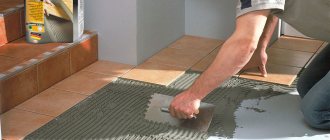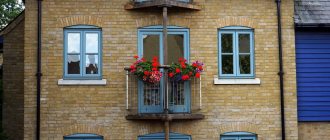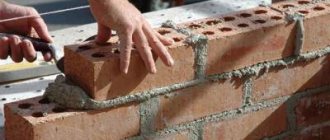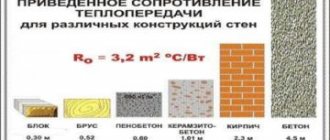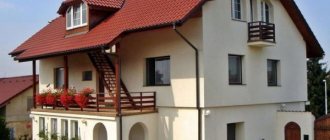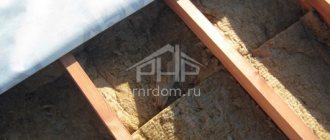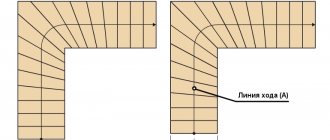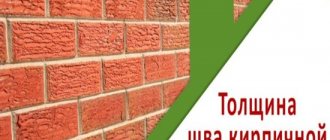A brick wall in the living room interior is an original and unusual element. Standard wall design involves multi-layer coating of a brick or concrete wall in order to give it an attractive appearance, completely different from the base material. However, brickwork is a very expressive element and can serve as an interior tool.
A wide variety of materials are used. White brick is most often found in the living room interior. In the kitchen and bedroom, facing bricks are more often used. You can even meet people of color in the corridor. This solution is extremely versatile and allows you to solve many interior problems.
Brick houses
The thickness of the walls in brick buildings is formed during laying. For example, a standard brick has a width of 120 mm. If the masonry is done in two rows, then there is a seam of about 10 mm between them. Accordingly, the thickness of such a wall will be 250 mm. If the wall is laid out in three rows, then its thickness will be 380 mm and so on.
Measuring walls
The simplest method of determining a load-bearing wall is measurement. Walls of 80, 120 or 250 mm are partitions. Accordingly, a wall thickness of 380, 520 mm or more is always load-bearing. Also be sure to take into account the layer of plaster and other finishing materials when measuring.
The main mistakes when decorating a room with a white brick wall
White brick is not as simple as it seems at first glance. Silicate masonry can visually enlarge the space, but sometimes it makes the interior heavier and can unbalance the harmony. What to pay attention to when decorating a room:
- Insufficient lighting. Sand-lime brick takes on a gray tint, making the space visually heavier. Natural facing materials look dirty gray. With wallpaper this effect can be avoided.
- Wrong choice of shades. Designers mean a palette of colors by white: “ivory” with a slightly noticeable creamy tint creates a warm and “baked milk” differs from “ivory” in the richness of yellowish shades, “arctic snow” repels with coldness, makes the interior uninhabited, boiling white is associated with hospital, sterility, Stockholm has a grayish-yellow natural, subtle tint, it also belongs to the category of warm.
- Unsuccessful combination with ceiling and floor. Gloss is undesirable on the ceiling, and too contrasting a color on the floor.
- Creating a monochrome interior. Too much white is bad. The interior loses its individuality and lived-in feel. It seems to push people out, creating an uncomfortable energy.
- Variety. When experimenting with a white brick wall in the interior, it is worth observing a sense of proportion. Any colors look contrasting. If there are a lot of them, it starts to dazzle your eyes.
Interior in Scandinavian style - following fashion trends. Brickwork creates a special atmosphere of cleanliness in the home. The main thing is to choose the right shade of white and properly dilute the decor with wall decor. Manufacturers offer all kinds of finishing materials for different types of apartment premises.
Partitions
Partitions are subject to force impacts from their own mass within one floor, minor random force impacts during operation (when moving furniture, equipment, etc.), and non-force acoustic impacts. Partition structures, in accordance with the degree of fire resistance of the building, are designed with a fire resistance limit of 0.5-0.25 hours from fireproof or fire-resistant materials.
This low level of regulatory requirements for the fire resistance of partitions is due to the fact that their damage in a fire is usually local in nature and cannot affect the safety of the building’s load-bearing structures.
Low regulatory requirements for the strength and fire resistance of partitions allow them to be made from a wider range of materials than internal walls.
Partition structures are designed depending on the degree of fire resistance of structures made of brick, stone, concrete, gypsum concrete, wood and other non-concrete materials. The soundproofing ability of partitions is provided according to the principle of acoustically homogeneous or separate structures, depending on the selected material of the enclosing structure. The least industrial partition design is in the form of a thin wall, built manually from brick or small slabs; the most industrial is panel, single-row cut. Partitions made from small-sized products are outdated and even in houses with brick walls they are giving way to panel ones. In large-block and panel buildings, partitions are made from single-row cut panels (solid or with openings) the size of a room. Partition panels are formed from heavy or light concrete with a thickness of at least 60 mm or from gypsum concrete with a thickness of at least 80 mm. Inter-apartment partitions, as a rule, are designed to be acoustically separate, double, with an air gap between the panels of at least 40 mm. The designs of the partition panels and their fastening details are shown in Fig. 10.
Partitions made of non-concrete materials (Fig. 11) are designed, as a rule, layered in the form of frame or frameless (glued) panel-type structures or element-by-element assembly. The frame of such partitions is made of plank slats, aluminum or thin-walled galvanized steel rods of rectangular tubular or channel cross-section with double-sided lining with gypsum dry plaster and filling of the cavity with mineral or glass wool materials. The partitions are mounted along guides made of metal or wooden slats, fitted with dowels to the floor and ceiling. Vertical joints of partition panels are made into tongues and grooves onto spacer strips that fit into the grooves of the vertical strappings. Partition panels are made one floor high with a main width of 1.2 m and additional elements 0.6 and 0.3 m wide.
In buildings with a layout that can be transformed during operation, sliding partitions are used. Depending on the material used, a soft harmonious or hard folded structure (Fig. 12) of a sliding partition is used.
Rice. 10. Partitions made of gypsum concrete panels - general view of the panel; b - connection to the ceiling; c - connection to the floor; 1 - lifting loop; 2 - wooden slatted frame; 3 — door block; 4- lower wooden frame (support beam); 5 - metal clamp for joining with the ceiling
Rice. 11. Panel partitions made of non-concrete materials - adjacent to the ceiling; 6 - connection to the floor; c - connection to the wall; g - connection to the door frame; d - vertical joint; 1 - frame; 2 - casing; 3 - soundproofing layer; 4 - plinth; 5 - harness; 6 - butt rail
Work on mistakes
Using such a simple and yet quite complex material, it is necessary to take into account some features of brick:
- Once the wall is painted, it is extremely difficult to remove the paint if necessary. This is due to the porosity of the structure and good absorption.
- It is not advisable to completely highlight a long wall with brick. In this case, it must be “broken” with pieces of furniture, mirrors or decor. This way it will be better perceived visually.
- Mirrors reflecting a brick wall will help unite the space of the room into a single ensemble.
- The paintings look very beautiful on brick walls. The more there are, the more attention is drawn to the wall itself.
- Hanging open shelves hung on such a wall add coziness. Their color and material are selected taking into account the style of the room.
Bright accent
VIDEO: How can you use brick on a wall?
Brick wall
Ideas for your interior
Types of foam blocks, their sizes and thickness
To build a durable partition that will last a long time, you need to understand the types of foam blocks.
First of all, you need to understand that foam concrete blocks with different densities are used for external and internal walls. For the construction of external walls, foam blocks with a density of at least D 300-500 are used. Internal partitions can be erected from less durable foam blocks. In addition to the density, this material also differs in the manufacturing method. There are autoclave and non-autoclave methods. The latter is more often used by small enterprises that do not have good quality due to poorly established technical control.
The non-autoclave manufacturing method creates uneven porosity of the material. As a result, a partition made of such blocks shrinks by about 3 millimeters on a section of the wall 1 meter high. Therefore, a partition made of foam blocks made by autoclave will be much stronger.
This material also differs in the stamping method. this could be cutting or forming blocks. In the first case, blocks are cut from foam concrete with a special circular saw. The result of this manufacturing method is geometric evenness of the edges and perfectly matching block sizes.
With the molding manufacturing method, liquid foam concrete hardens in special forms. Although all forms are standard sizes, block sizes may vary. This is the minus of molding.
Therefore, when purchasing material, it will be completely natural to give preference to foam blocks made by cutting.
Separately, it is worth highlighting the issue of the size of foam blocks for partitions. Typically, blocks with the following parameters are used for the construction of interior partitions:
- different thicknesses: 50, 75, 100 or 150 mm;
- height and length - standard 300 mm x 600 mm;
- weight depends on thickness and density 5.5 kg - 16.2 kg;
- optimal density D600.
Foam blocks with such parameters are suitable for partitions of any height.
Blocks with a thickness of 100 mm are most often used. Despite their small thickness, interior partitions made from foam blocks are durable, with good soundproofing and fire-resistant characteristics.
Selection of material
Today, bricks such as single, one-and-a-half and double are produced. A standard brick has a size of 0.25 × 0.12 × 0.65 m. This standard was approved back in 1925. A little later, standards were approved for one-and-a-half and double bricks, respectively, 0.25 × 0.12 × 0.88 m and 0.25 × 0.12 × 0.138 m. It is believed that the latter types of brick are considered more economical.
Related article: Insulation for exterior house walls under plaster
As practice shows, for a load-bearing type structure it is more profitable to use 2.5 bricks. In this case, the cladding should be done using a single method, as it looks more aesthetically pleasing. If you use only a single brick with this type of masonry, the cost of such material will be thirty percent more.
One of the most important characteristics of brick is its thermal conductivity. Although brick is considered to be quite thermally conductive, it is inferior in this indicator to materials such as wood and foam concrete.
This important characteristic can be significantly improved by using hollow materials for cladding. It is very important to know that such materials cannot be completely used for the construction of load-bearing structures, since its strength is significantly less than that of a solid one.
In addition, this type of material absolutely cannot be used in the construction of foundations and foundations of buildings.
Brick houses
Currently, the percentage of construction of brick houses has noticeably decreased. This is due to the relatively high cost of materials and the duration of work compared to other construction methods. It takes 1.5-2 years to build a high-rise building made of brick (10-18 floors). This figure is 30% higher than the construction of monolithic structures and 50% higher than panel ones. Modern brick apartment buildings belong to the premium housing segment.
Construction technology
Brick buildings are the most suitable for living, in particular if ceramic bricks were used in their construction. The ceramic material is considered environmentally friendly, capable of receiving and releasing moisture, as well as regulating the microclimate in the apartment. In addition, it is an excellent thermal insulator, which allows you to reduce utility bills for heating.
Sand-lime bricks can also be used in the construction of high-rise buildings. Its thermal insulation properties are not as high as ceramic ones, so the walls are additionally insulated.
Nowadays, houses are not often built from only one brick. Developers give preference to combined monolithic-brick structures. This design allows you to increase the operational life of the building and diversify its architecture.
Pros and cons of brick
- From an architectural point of view, it is possible to construct any structures from brick.
- Designers are not limited by standard layouts.
- High confidence in the material among buyers.
- The best heat and noise insulation performance among all construction technologies.
- The material is able to absorb and release moisture. This eliminates problems such as the occurrence of mold and fungi due to dampness in the room.
- Long service life - up to 150 years.
- The most pleasant microclimate indicators, that is, the room is not cold in winter and not hot in summer.
The material has significantly fewer disadvantages than advantages, but they are still present:
- Brick does not conduct sounds well, but is not a guaranteed protection against household noise.
- High cost of apartments in brick buildings.
- Long construction period.
We combine the incongruous
A brick wall is original, impressive and fashionable. But how can you choose the rest of the design as organically as possible?
Designers advise:
- Very often such a wall combines several shades. In this case, it is better to select furniture using the darkest and lightest colors as a basis.
- The rigor of the design can be enlivened by a bright carpet or eye-catching accents, such as colorful pillows on the sofa.
- Red brick color goes well with orange, yellow, and blue. This combination is especially effective in oriental ornaments.
Do's and Don'ts
Monolithic houses are the most acceptable options for redevelopment. After all, almost all the walls and partitions in the apartment are non-load-bearing. Therefore, a large number of changes are allowed based on the preferences of the owners, as well as in accordance with the requirements and standards for the redevelopment of any residential premises.
This takes into account compliance with the following standards:
- construction;
- sanitary and hygienic;
- firefighters.
Conclusion on fire safety
It is worth remembering that there are prohibited actions when carrying out redevelopment in a monolithic house.
These include:
- violation of the integrity of the supporting structures of the apartment;
- creation of residential premises without windows and heating, with an area of less than 9 square meters;
- changing the gasification, sewerage, heating or ventilation systems without appropriate permission;
- equipment of bathrooms, kitchen spaces above the living rooms of neighbors.
Redevelopment in a monolithic house opens up many prospects. However, it must also be carried out legally. Therefore, you need to coordinate your own actions in advance.
In controversial situations, after the reconstruction of the premises, the redevelopment can be legalized through the court.
With which authorities it is necessary to coordinate a project for the redevelopment of non-residential premises, read here.
- Due to frequent changes in legislation, information sometimes becomes outdated faster than we can update it on the website.
- All cases are very individual and depend on many factors. Basic information does not guarantee a solution to your specific problems.
That's why FREE expert consultants work for you around the clock!
- via the form (below), or via online chat
- Call the hotline:
- Moscow and the Region
- St. Petersburg and region
- Regions
APPLICATIONS AND CALLS ARE ACCEPTED 24/7 and 7 days a week.
Using bricks: tips and tricks
How to preserve masonry and avoid tarnishing and defects?
Real brick is beautiful in itself, has a pronounced texture and a characteristic shade. How to preserve it without losing quality characteristics and color? For this, interior designers advise using special protective compounds.
If there is a lack of light, which occurs, for example, in a hallway, the wall can be varnished with a slight glossy effect. This will ensure color preservation.
In sunny rooms, you can varnish with a matte effect. Such protection will be completely invisible, but at the same time quite reliable.
In an industrial interior
Is old brick good or bad?
The old brick wall looks historic, attractive in its rugged beauty. But for the interior it must first be put in order. For this purpose, brushing is used. You may need to wipe the stained areas with a mixture of vinegar and water.
Advice: Before using aggressive cleaning agents, check the condition of the brick. A crumbling surface cannot be treated this way.
With the effect of old brick
High humidity: how to overcome it?
In rooms where there is often high humidity, such as a bathroom, protecting the brickwork comes first. To do this, the crumbled seams are deepened a couple of centimeters, and then restored with a new solution. The next step is sealing to protect against mold.
Protecting brickwork
How to find out if a wall is load-bearing
The easiest way is to look at the house design. All the walls are clearly marked there. The plan must be kept in the city administration, in the capital construction department.
In addition, you can also use the apartment plan, which is located in those. passport or house register. However, to do this you need to be able to read blueprints or have experience in construction.
Video: Olga Rozina: how to identify a wall
If for some reason the plan cannot be found, then the purpose can be understood by some characteristic features. So, for example, if behind the wall there is a neighbor’s apartment, an entrance or a street, these are load-bearing.
Another way to find out is by thickness. If you live in a brick house and the thickness of the partition is 38 cm, then it is load-bearing. In a panel, the thickness of the load-bearing walls is 14 cm or more.
In a brick house
In brick houses, the thickness of the exterior starts from 38 cm, between apartments from 25 cm, interior - 8 - 12 cm. The main material in the construction of such houses is silicate and red brick.
For partitions, gypsum slabs can be used. By measuring a wall, for example, in the area of a doorway, you can determine whether it is solid or a partition.
However, this method is not suitable for all homes. For example, in the 90s, houses were built according to individual projects, so if there is no plan, then only the author of the project can determine.
In panel
Since the panel house consists almost entirely of load-bearing structures, it will be very difficult to implement the planned redevelopment. Load-bearing walls include inter-apartment, external and adjacent to external walls. In addition, the walls of bathrooms can also be load-bearing.
Interior partitions have a thickness of 8 - 10 mm. There are partitions of 12 cm, but this is a rare exception. To determine the purpose of the walls in this case, it is better to contact specialists who will draw a conclusion only after studying the design features of the building and decide whether redevelopment can be done.
In monolithic houses
It happens that an ordinary interior partition in monolithic buildings has a thickness of more than 20 cm. There are monolithic houses in which load-bearing walls are completely absent. They are replaced by reinforced concrete columns.
And in this case, you cannot do without a drawing and plan. If they are missing, you will have to contact specialized companies.
Making a white brick wall with your own hands
Inspired by pictures in web resources, craftsmen who prefer to do repairs themselves take on the task of creating masonry or its imitation. A few recommendations from experts will be a good guide to action.
Several methods are used in the interior design of apartments and houses:
- They improve fresh brickwork in new buildings, or when making inter-wall partitions. The easiest way is to coat sand-lime bricks with a special protective compound that creates a matte surface, or with varnish that creates a gloss. Pre-contaminants are removed from the treated area.
- Opening up old masonry. Painstaking, dusty work. All layers will have to be removed: finishing material, primer, plaster, traces of construction dust, build-up of mortar. The exposed masonry is leveled with a surface grinder and the top layer of silicate chips is removed.
By the way, designers advise cutting the seams to a depth of 1 cm and covering them again using profile rubber, forming an even concrete roller.
- Laying lightweight transom bricks. Factories produce an elongated Euro version or a standard cladding, three times thinner than a single brick. Kirzavods make custom-made bricks for any design project. Such products are more expensive, but using them you can create a unique interior with your own hands. For masonry, purchase construction adhesive; it adheres well to drywall, concrete, and wood.
- Imitation of a white brick wall, how it’s done
The easiest way is to stick wallpaper with a foam layer that recreates the shape, color, and texture of natural silicate building material. Photo wallpapers depicting a fragment of ancient masonry look impressive.
Hand-painted walls, artists manage to recreate the look of ancient masonry with black paint on a white background. Sometimes, to visualize dullness, sand spraying techniques are used using stencils that limit the finishing area.
The use of facing veneers made of clinker or ceramics that imitate natural brick. Their thickness is up to 3 cm, and the kit usually includes installation paste for various types of surfaces. To create even seams, plastic crosses are used.
The material is made in several variations:
- Artificially aged;
- Matte;
- Glazed.
By the way, molds are made from gypsum yourself - gypsum dough is poured into a flexible polymer mold. The mixture hardens in 1 minute, after which the finished dies are dried for 24 hours in an unventilated room. Gypsum is very fragile, the dies break when dropped, it is important to be careful when lining.
Installation of partitions from foam blocks
In recent years, a more modern and practical material has appeared in construction - foam concrete and foam blocks made from it, which are perfect for constructing interior partitions. This building material has a whole list of priority qualities. He:
- relatively lightweight with impressive dimensions;
- has good heat and sound insulation;
- easy to process, flexible for cutting holes, channels for pipes and electrical wiring;
- easy to saw with a hacksaw, ideal for realizing all kinds of design ideas, for creating arches and any configurations;
- has sufficient thickness to form a doorway in the wall;
- has a smooth surface and is perfect for any decorative finishing, priming, tiling, plastering, wallpapering;
- resistant to sun, moisture, temperature changes and active biochemical substances;
- has an affordable price.
Such excellent characteristics make foam blocks an indispensable building material for organizing partitions in houses, apartments, offices and industrial premises.
The only drawback of foam concrete blocks is that the shape is not always ideal. Therefore, it is preferable to purchase this material from large manufacturers, where product quality checks are more thorough and the geometric shape of the blocks meets standard standards.
How to attach the Mauerlat to the wall? You will find out the answer to this question by reading this article.
And this article talks about installing corrugated sheeting on the roof.
Types of facing material “brick”
Currently, wall cladding with decorative bricks can be made from various materials:
- polystyrene foam;
- clinker;
- gypsum;
- polyurethane.
Clinker is pressed clay that has been fired. This cladding retains its properties in any conditions, so it is used both inside and outside. Not afraid of ultraviolet radiation and chemicals, water, and severe frosts. Harmless. Made with the addition of coloring pigment. The colors are very varied. The cost is relatively high, but the quality of the material is worth it.
Plaster is easy to work with when carrying out any repair work. Very light. Installation is quite easy to do yourself. One of the cheapest materials. Very wide color spectrum. Excellent insulating properties. The only drawback is that it is afraid of moisture.
Public places are usually decorated with public places. It is rarely used at home, since up close it doesn’t look much like a brick. Afraid of the sun. The paint fades quickly.
The most inexpensive finishing material is polystyrene foam. It is fragile and therefore short-lived in use. That's why this finish requires frequent updating.
Methods for demolishing a load-bearing wall in a panel house
Dismantling partitions in panel houses does not cause any technical complications, but the demolition of a load-bearing wall, in addition to documentation, will require special techniques for demolishing the fence.
Today, there are two main options for demolishing a load-bearing wall in a panel house.
Inserting a load-bearing beam
In the case when the dismantled section of the fence is located between load-bearing walls, a crossbar (beam) is inserted, which is a powerful reinforced concrete beam or a metal I-section profile reinforced with stiffening ribs.
Installation of columns
Vertical supports can be reinforced concrete columns or metal posts.
As in the previous case, the floor slabs are supported by jacks. Install supports. The fence is being dismantled. Of course, you cannot undertake such work on your own.
Only professional workers can dismantle load-bearing structures.
All changes that have occurred in the layout of the apartment must be included in the technical passport.
Load-bearing walls in panel houses can be 14, 18 cm thick. In some series, from the first to the fifth floor, the thickness of the load-bearing wall in a panel house can be 22 cm. All load-bearing walls must have reinforcement. Diamond cutting of an opening or widening of an opening in such walls is carried out with a manual diamond cutter; diamond cutting of walls is carried out on both sides to obtain a through seam in the wall. An ordinary 220V electrical outlet is sufficient. The use of a hammer drill is kept to a minimum; it is used only as an auxiliary tool. The time for cutting a standard opening in the wall of a panel house is from 1.5 to 5 hours, depending on the thickness of the wall and the conditions at the workplace.
The thickness of the floors in panel houses is 14 cm. Hollow-core floor slabs with a thickness of 22 cm are also available.
Non-load-bearing partitions in panel houses are 8 cm thick. They are either concrete or plaster, but in both cases there is reinforcement inside the partition. Cutting the opening in the partition is also carried out with a manual diamond cutter, only on one side.
External walls in a panel house are 38 cm thick. They perform a heat-insulating function, so they are made of expanded clay concrete or a concrete sandwich with polystyrene foam inside.
The demolition of the window sill block is carried out by diamond cutting on both sides, followed by crushing with a hammer drill. There is reinforcement inside, sometimes quite thick. Using a hammer drill in this case takes up to half the work, that is, the work is loud.
The walls of the sanitary cabin, as well as non-load-bearing partitions, are 8 cm thick. They are made of either plaster, aceid, or concrete. In most cases, demolition of a plumbing cabin is carried out using hand tools and an ordinary grinder. This work takes 5 hours.
What a load-bearing wall cannot be demolished
Most often, redevelopment involves the demolition of interior partitions. But not everyone knows which walls can be touched and which ones cannot. Reckless demolition of structures leads to a change in the action of forces on the remaining surfaces and rooms located below. In addition, ceilings left without support may not withstand the load and collapse at any time. Since, in addition to separating different rooms, the wall elements serve as ceiling supports for all similar structural elements located above.
The main (load-bearing) walls in practice are located perpendicular to the floor beams. If it is made of concrete slabs, then their ends rest on the surface of the supporting structure. Usually these are walls between apartments and blocks, or external ones. As a rule, only partitions are equipped inside the apartment.
General requirements
Internal walls and partitions are the main internal vertical enclosing structures in buildings. In addition, internal vertical enclosing structures form structural elements combined with engineering equipment: sanitary cabins, ventilation blocks and shafts, elevator shafts, etc. The corresponding sections are devoted to the consideration of these structural elements. (see Categories)
Internal walls perform enclosing and load-bearing functions in the building, partitions are only enclosing. Wall and partition structures must meet regulatory requirements for strength, stability, fire resistance, sound insulation, be vapor and gas tight, easily erected and easy to clean. Partitions and walls of wet rooms must also be waterproof and waterproof.
The design of walls and partitions, the choice of their structure is carried out taking into account the listed, as well as economic requirements, since the construction of walls and partitions reduces up to 20% of the cost of building structures and 15% of labor costs for its construction.
The level of regulatory requirements for the strength and fire resistance of wall and partition structures varies due to the different roles of these structures in the static operation of buildings.
The general enclosing function of internal walls and partitions is to provide sound insulation from airborne noise. In this regard, the level of requirements for the soundproofing qualities of these structures coincides and depends not on their static role in the building, but on their location in it. For inter-apartment and intersection walls and partitions, for fences separating living rooms from staircases and elevator halls, the insulation index required by the chapter SNiP “Noise Protection” must be at least 50 dB, for interior walls - 41, for walls and partitions separating living rooms and sanitary premises of the apartment - 45, and for fences between living rooms and built-in shops or cafes - 55 and 60 dB, respectively.
To ensure sound insulation, acoustically homogeneous or heterogeneous structures are used. Massive single-layer enclosing structures with a solid or multi-hollow section are used as acoustically homogeneous ones; double walls and partitions, walls with a flexible screen, and multi-layer lightweight partitions are used as heterogeneous ones. The sound insulation method is chosen based on the appropriate use of the properties of the materials used.
Panel houses
The construction of apartment buildings using panel technology dates back to the times of the Soviet Union. At the end of the 50s of the 20th century, large-scale construction of panel plants began to provide housing for Soviet citizens. Such buildings have “survived” to this day.
Construction technology
The specifics of this type of construction are simple - using the “constructor assembly” method, the building is assembled from concrete slabs, and the joints between them are laid with cement mortar.
Currently, concrete panels have begun to be replaced with sandwich structures, the core of which is made of noise and heat insulation materials. The dimensions of such panels are larger than those of their predecessors, therefore, in houses built using sandwich structures, the ceiling height and distance between load-bearing walls are increased compared to conventional concrete panels.
Pros and cons of panel structures
- Construction takes the least amount of time (from 3 to 12 months), compared to brick and monolithic ones.
- The most affordable cost of housing, due to the low cost of materials and low energy and labor costs.
- The design service life is 40-50 years. The actual service life can be up to 1.5 times longer than the design one.
- Primary repairs do not require any special effort. The panel has a smooth and even texture that you can easily putty on yourself.
The disadvantages of multi-apartment panel buildings are:
- The layout is designed in such a way that it cannot be changed - most of the walls are load-bearing.
- Low level of sound insulation. An excessively high level of audibility is achieved due to the small thickness of the panels.
- Poor thermal insulation. The reasons for this shortcoming may be the small thickness of the panels or poorly sealed joints between them, which unscrupulous developers are often “famous for.” You can increase the level of thermal insulation only by installing an additional layer of insulation yourself, which entails additional costs.
Modern panel-type buildings are superior to Soviet ones in the following indicators:
- The layout of the room has been noticeably improved.
- It is possible to purchase an apartment with an already glazed balcony and two bathrooms.
- Various building facades.
- High-quality multilayer panels provide higher levels of noise and heat insulation.
Selection of material
At the moment, the industry produces single, one-and-a-half and double bricks. The dimensions of the standard (single) are 0.25 x 0.12 x 0.65 m. This standard was adopted in 1925 by the domestic standardization system. A little later, one-and-a-half and double standard sizes appeared - 0.25 x 0.12 x 0.88 m and 0.25 x 0.12 x 0.138 m, respectively. At the same time, one-and-a-half and double ones are more economical.
Thus, for a load-bearing structure of 2.5 bricks, it is economically beneficial to use double and single facing bricks. At the same time, they always try to make the cladding single: such masonry has a more aesthetic appearance. If only a single product is used for such masonry, you will have to pay about 30% more for the material.
One of the important functions of brick walls is thermal conductivity. Although this building material has a relatively high value, it is significantly lower than that of a number of other building materials. In this indicator, brick is significantly inferior to wood or foam concrete.
However, the thermal insulation properties can be significantly improved by using hollow versions of the cladding material. It is completely impossible to use hollow material for the construction of load-bearing structures; it is significantly inferior in strength to solid material.
Also, hollow materials cannot be used in the construction of foundations, bases, plinths, etc.
Stages of redevelopment in a monolithic house
Due to the free layout of apartments in monolithic buildings, it is possible to realize the most daring ideas of designers and architects.
If the redevelopment is carried out completely, then there are several stages of its implementation:
- You can turn an ordinary kitchen into a studio. At the same time, you are allowed to change its size and location. After all, the area of the area for cooking and eating often does not meet the owner’s requirements. Therefore, the kitchen can be combined with the room.
- You can increase the area by combining the bathroom. Designers are playing with a shared bath and toilet. This measure allows you to expand the space by rationally using the wet area.
- Changes are noted in the number and area of living rooms. If they are not enough for each family member, there is the option of adding new premises. This can be achieved by dividing one bedroom into two, capturing part of the corridor or storage room.
- By taking away the corridor area, you can make the living room more spacious.
- The owner can arrange niches, dressing rooms, utility rooms. Zoning the space would also be an excellent option.
Rules for using masonry in the interior
Rule #1
Don't be afraid to experiment!
Rule #2
Be guided by a sense of proportion and knowledge of style.
Rule #3
Having decided to experiment, use brick finishing in reasonable proportions, highlighting with it:
- fireplace area (or hearth area);
- individual architectural elements: niches, columns, arches, partitions;
- accent wall.
By over-decorating the walls with white brick, you can get an uncomfortably cold atmosphere instead of the expected stylish sophistication.
Using this solution, you can highlight specific zones in the interior
We demolish walls during redevelopment, what can be demolished and what cannot
Many people, especially those living in Khrushchev-era apartment buildings, try to remodel their small and uncomfortable apartments using redevelopment. But it’s one thing to do it in an individual building, and quite another to change a doorway or move a partition in a high-rise building, where almost every wall is load-bearing. All this ensures the safety of residents in combination with the entire technical design of the house.
What is redevelopment? According to the Housing Code, this concept includes all changes in the configuration of the apartment that require inclusion in the technical passport. This:
- changing the location of load-bearing walls and partitions,
- relocation of window and door openings,
- re-equipment of vestibules and dark storage rooms,
- arrangement of internal stairs,
- refurbishment of bathrooms,
- division of large rooms,
- expansion of living space due to household premises,
- glazing of a balcony or loggia,
- replacing gas stoves with electric ones,
- moving a bathroom, kitchen or toilet.
All these types of changes in the apartment relate to redevelopment and require approval from the relevant authorities.
Advantages and disadvantages of using white brick walls
Designers are ambivalent about interiors using white brick. There are arguments “for” and categorical “against” masonry and its imitation in apartments. It's hard to argue with this, everyone has different tastes.
First the good:
- Silicate masonry is strong and durable;
- Does not ignite when exposed to high temperatures;
- This is an environmentally friendly material; bricks are made from sand and lime by sintering:
- Helps create eclectic interiors;
- Has good sound insulation;
- Keeps the home warm.
The main disadvantage is the high specific gravity. When laying walls internally or building partitions, the space is too reduced. The internal masonry is made of ordinary brick, without cladding. The surface must be protected from destruction with special compounds based on polymers and resins.
Tools and materials used for laying foam blocks
Before starting work on constructing a partition from foam blocks, you need to prepare a set of necessary materials and tools:
- glue for foam blocks at the rate of 15 kg per 1 cubic meter. meter (with a layer of 2 mm);
- cement mortar for laying the bottom row;
- mounting foam for foaming the gap between the top row and the ceiling;
- foam gun;
- pins - self-tapping screws, metal embedded pins;
- spatulas and trowel;
- a drill with a mixer for mixing glue and cement mortar, a container for glue;
- a hammer with a rubber pad for leveling blocks when laying;
- construction laser or regular level;
- corner, wood hacksaw for sawing blocks;
- a plane or grater for foam blocks to level the surface before finishing;
- electric milling cutter or wall chaser for making holes and grooves in the partition;
- a large brush for sweeping away concrete dust from rows before applying glue.
After preparing everything necessary for the construction of a wall partition made of foam blocks, you can proceed directly to the beginning of work.
Technology for laying ondulin on the roof. You will read about this in our next article.
And here is an article about laying cork flooring.
Brick partitions: little secrets and subtleties of masonry
When erecting a single or half partition, you need to take into account the construction features. They will help you avoid mistakes and make a reliable design:
- a partition can only be built on a prepared foundation; before its construction, a reinforced concrete screed is laid out;
- the solution should be plastic, viscous, but not too liquid, otherwise it will come out of the seams. The thickness of the seam is from 10 to 12 mm. One of the best compositions: 4 parts sand, 1 part M500 cement, part water;
- a layer is laid between the floor and the wall that prevents the spread of vibration and hydration of the room (2 layers of roofing material);
- In order for the partition to hold firmly, you need to secure it with grooves up to 5 cm deep. The outer parts of the structure are inserted into these holes;
- It is necessary to bandage the seams when constructing a brick structure. If this is a partition of 0.5 bricks, then a vertical bandage is made (the seams are in the middle above the bricks of the previous layer);
- In order for the structure to be durable, it must be reinforced with wire rods;
- For processing, before applying the decorative layer, be sure to cover the brick with plaster. With this technology, you need to take into account the width of the joints - it should not protrude beyond the boundaries of the brick;
- When building a partition, it is better to use wet bricks, previously soaked in water.
To follow these simple recommendations, you do not need specific work skills.
We demolish walls during redevelopment, what can be demolished and what cannot
Many people, especially those living in Khrushchev-era apartment buildings, try to remodel their small and uncomfortable apartments using redevelopment. But it’s one thing to do it in an individual building, and quite another to change a doorway or move a partition in a high-rise building, where almost every wall is load-bearing. All this ensures the safety of residents in combination with the entire technical design of the house.
What is redevelopment? According to the Housing Code, this concept includes all changes in the configuration of the apartment that require inclusion in the technical passport. This:
- changing the location of load-bearing walls and partitions,
- relocation of window and door openings,
- re-equipment of vestibules and dark storage rooms,
- arrangement of internal stairs,
- refurbishment of bathrooms,
- division of large rooms,
- expansion of living space due to household premises,
- glazing of a balcony or loggia,
- replacing gas stoves with electric ones,
- moving a bathroom, kitchen or toilet.
All these types of changes in the apartment relate to redevelopment and require approval from the relevant authorities.
What cannot be demolished: a load-bearing wall
Most often, redevelopment involves the demolition of interior partitions. But not everyone knows which walls can be touched and which ones cannot. Reckless demolition of structures leads to a change in the action of forces on the remaining surfaces and rooms located below.
In addition, ceilings left without support may not withstand the load and collapse at any time.
Since, in addition to separating different rooms, the wall elements serve as ceiling supports for all similar structural elements located above.
The main (load-bearing) walls in practice are located perpendicular to the floor beams. If it is made of concrete slabs, then their ends rest on the surface of the supporting structure. Usually these are walls between apartments and blocks, or external ones. As a rule, only partitions are equipped inside the apartment.
How to find out which wall is load-bearing?
Is it possible to determine the purpose of the wall yourself? Certainly. By its thickness or the material from which it is built. In panel-type houses, internal blocks have a thickness of up to 120 mm. Therefore, they can be considered partitions (their thickness ranges from 80-120 mm).
The load-bearing surface must have a thickness of at least 140 mm. Most often, in such houses, the external walls are made with a thickness of 200 mm. In brick houses, external, load-bearing structures have a thickness of 380 mm or more, inter-apartment structures - 250 mm, and partitions - 120 or 80 mm.
The material most often used for load-bearing walls in panel houses is wall or inter-apartment blocks made of reinforced concrete with various additives to lighten the structure and increase thermal protection. Internal partitions in 90% of panel houses are made of gypsum concrete panels. In brick buildings, the main material for all walls is red and sand-lime brick, which differ in size. Gypsum concrete panels can also be used as partitions.
Of course, no one is going to demolish the outer walls, but the partitions can be removed by obtaining the appropriate permission. To accurately determine which wall is load-bearing, it is best to use BTI data - a detailed floor plan. There, all main walls are marked with thicker lines, and partitions that do not have such functions are marked with thinner lines.
Design options for different rooms with a white brick wall
Natural masonry or its imitation is appropriate in many modern styles, from the boring sunny Provence or Gothic to minimalism, high-tech, and moderately colored loft. A white brick wall is the personification of purity, evidence of good taste. Such decoration has the right to exist in rooms with different functionality: bedroom, living room, bathroom. The versatility and variety of shades of white is increasingly used in interior design. The apartment is being transformed and becomes modern.
Living room
Usually the largest and brightest room is allocated for the living room. With sufficient lighting and a large number of rooms, a Scandinavian style will be appropriate. Brick cladding is advantageous in special areas of the room for receiving guests:
- On partitions that occupy part of the room along the length;
- Arched ceilings;
- Columns;
- By the fireplace;
- On one of the walls, it is decorated completely or fragmentarily.
Using decorative masonry techniques, they create amazing interiors. A living room with a white brick wall does not become boring and always looks fresh.
Kitchen
Natural materials are more often used in the stove area - they make heat-resistant aprons that are exposed to heat. Decorative cladding made of glazed veneers that are resistant to destruction is acceptable for the sink. This coating is easy to clean. With good lighting and panoramic windows, it is permissible to leave natural masonry on all walls. By highlighting one wall, you can advantageously emphasize the overall compositional color scheme. In large kitchens, a white wall helps to zone the space; the dining area stands out.
Bedroom
Soft shades of white are chosen for the resting place; the fresh natural masonry exudes coldness and discomfort. Against the background of rough brick, attention is focused on textiles, which are rich in any bedroom. It is permissible to make one or two masonry walls in the area of one of the sides of the bed, the headboard. The textured finish of the remaining walls of the room helps to avoid medical “sterility.”
Children bedroom
White masonry is an excellent solution for a play or dressing area. Niches and shelves are decorated with it. In the area of the bed, only photo wallpaper or covering the walls with textured vinyl wallpaper in a brick look is appropriate.
Bathroom
Natural sand-lime brick becomes rough when exposed to moisture, and the edges begin to crumble. It is advisable to use artificial moisture-resistant materials. In the bathroom, they recreate a semblance of the sterility of spa salons or use elements of the Gothic style using black wrought iron shelves, a cast iron bathtub that is unpainted on the outside. This interior looks stylish. More often, a fragment of the wall is recreated in the mirror area, where there is intense lighting. This is what many people limit themselves to. The rest of the space is tiled with traditional light tiles.
By the way, some manufacturers produce waterproof facing bricks, in which resin-containing components are used to bake a mixture of sand and lime. When using such material, you don’t have to worry about the appearance of the wall.
Hallway/corridor
Surfaces lined with veneers are practical, easy to clean, and are not afraid of drops of rain, snow, or dirt brought in from the street. In apartments with high ceilings in narrow hallways and corridors, white masonry helps to avoid the “well” effect. For contrast, one or two walls are made colored; it is better to use plain wallpaper, painting, or textured plaster.
